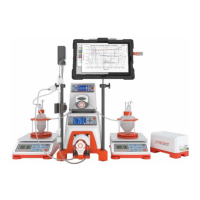Basic Concepts of Tangential Flow Filtration
12.1 Introduction
Membranes use the principle of barrier separations to differentiate components based on size.
Components larger than the membrane pore are quantitatively held back by the membrane while
smaller components pass through the membrane structure along with the permeate. Although there
are other methods for driving the separation process, SpectrumLabs.com’s HF TFF modules are
designed for pressure-driven applications.
Tangential Flow Filtration is an efficient way to separate streams that would quickly become plugged
if processed by dead-end filtration techniques. Most of the process fluid flows along the membrane
surface, rather than passing through the membrane structure. Fluid is pumped at a relatively high
velocity parallel to the membrane surface.
Except for water treatment applications, only a small percentage of the tangential flow along the
membrane surface ends up as permeate. In most cell and particle separations, only 1-5% of the inlet
flow to the membrane device becomes permeate. The remaining 95-99% exits the membrane device
as retentate. The retentate is recirculated back to the process reservoir and the module inlet so that
another 1-5% can be removed as permeate. This recirculation process continues in rapid succession,
generating a significant and continuous permeation rate.
Filtrate flow results in a build up of retained components on the membrane’s inner lumen surface—
these may occasionally accumulate into a cake layer instead of being carried away by the sweeping
action of the recirculation fluid. This cake layer becomes a membrane barrier, reducing the
functional size of the membrane pore and affecting module performance.
Caking is influenced by fluid variables: degree of solvation, concentration and nature of the solids
and solutes, fluid temperature, along with operating variables—such as the solution’s velocity along
the membrane—and TMP. Controlling this phenomenon by ensuring adequate fluid velocity at the
liquid-membrane wall interface will maximize flux, solute passage, and optimize process parameters.
Fluid velocity is controlled by the pumping rate. Pumping rate depends on the quantity of fibers in
the module and shear rate considerations. Typically, a shear rate of 12000s-1 is used for filtration
applications and up to 4000s-1 is used for perfusion applications. However, some certain
applications work well at reduced rates while others may require rates that are significantly higher.
These are the considerations that the user usually investigates during Research and Development
prior to moving to Pilot phase for their applications.
12.2 Concentration
Concentration is the reduction of the initial sample volume to a lower, final sample volume. The
opposite would be a dilution—where the initial sample volume is lower than the final sample
volume through the addition of buffer or other medium. If the process volume is 10L and needs to
be concentrated to 10X, then the final sample volume will be 1L. By removing 1-5% of each sweep of
recirculated process volume, SpectrumLabs.com’s HF TFF modules will gradually reduce the initial
sample volume’s weight. When using Feed and Permeate Scales, this weight loss is communicated to
the TFF system so that the TFF system knows when the process volume has been reduced to its
desired concentration factor. As the weight decreases on the Feed Scale and increases on the
Permeate Scale, the TFF system knows that the process volume is being concentrated. If the weight
stays constant on the Feed Scale while increasing on the Permeate Scale, the TFF system knows that
the volume is undergoing a fed-batch concentration.

